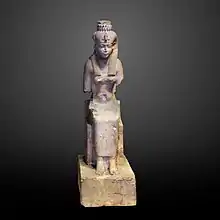Raet-Tawy
Raet (Rˁỉ.t) or Raet-Tawy (Rˁỉ.t-tȝ.wỉ) is an ancient Egyptian solar deity, the female aspect of Ra. Her name is simply the female form of Ra's name; the longer name Raet-Tawy means "Raet of the Two Lands" (Upper Egypt and Lower Egypt).
| Raet / Raet-Tawy | ||||||||
|---|---|---|---|---|---|---|---|---|
 Ptolemaic statue of Raet discovered at Medamud, on display at the Louvre Museum. | ||||||||
| Name in hieroglyphs | ||||||||
| Major cult center | Medamud, el Tod, Thebes | |||||||
| Consort | Montu | |||||||
| Part of a series on |
| Ancient Egyptian religion |
|---|
 |
|
|
Origins
At least by the reign of the Fifth Dynasty, Raet is the counterpart of Ra from the start and did not have a separate origin. Although she was called the lady of the sky and the earth, after the Fifth Dynasty she never reached the importance of Hathor, who by then was also considered the wife of Ra (or, in other myths, his daughter).[1]
Cult
Raet was also considered a wife of Montu,[2] and she formed a triad with him and Harpocrates in Karnak and Medamud. Her feast day was in the fourth month of the reaping season.[1] The centers of her cult were at Medamud, El-Tod, and Thebes. A demotic manual from the Roman period with hymns to Raet has survived in fragments.[3]
Iconography
Replaced by Isis in literature after the 5th Dynasty, as Osiris "takes the throne of Ra," images of Raet are rare. When she is depicted, she is shown as a woman with cow horns holding a sun disk on her head, similar to the headdress of Hathor. Additionally, any representation of Isis can be considered a type of rendering of Raet. The headdress is adorned with a uraeus or with feathers.[1]
Etymology
As Ra representing "operative creative powers" of speech, Raet stands for the storehouse or written aspect of language.[4]
With the Canaanite/Phoenician alphabet and Etruscan Old Italic script being almost identical, there is reason to believe Raet has links to Etruscan Rhaetia and Veneti Reitia, both often translated as She who writes.
References
- Richard Wilkinson: The Complete Gods and Goddesses of Ancient Egypt. London, Thames and Hudson, 2003. ISBN 978-0500051207 p.164
- Wörterbuch, p.402
- Kockelmann, Holger (2003). "A Roman Period Demotic Manual of Hymns to Rattawy and other Deities (P. Ashm. 1984.76)". The Journal of Egyptian Archaeology. 89.
- Wallis Budge: The Gods of the Egyptians. London, Methuen & C., 1904. OCLC 659445773 p.322
External links
 Media related to Rattawy at Wikimedia Commons
Media related to Rattawy at Wikimedia Commons